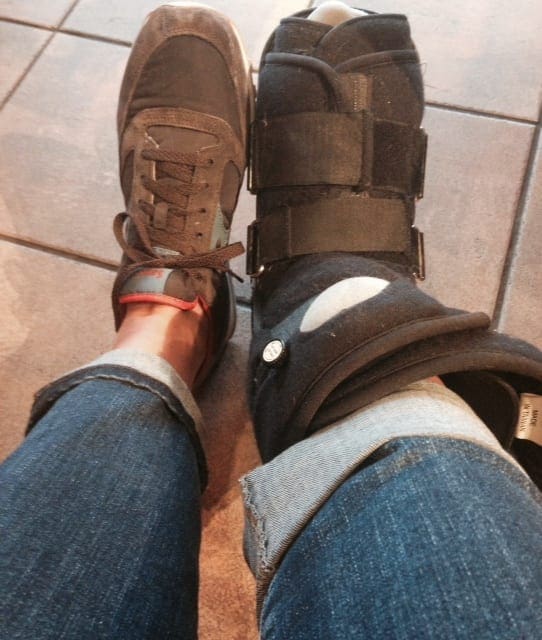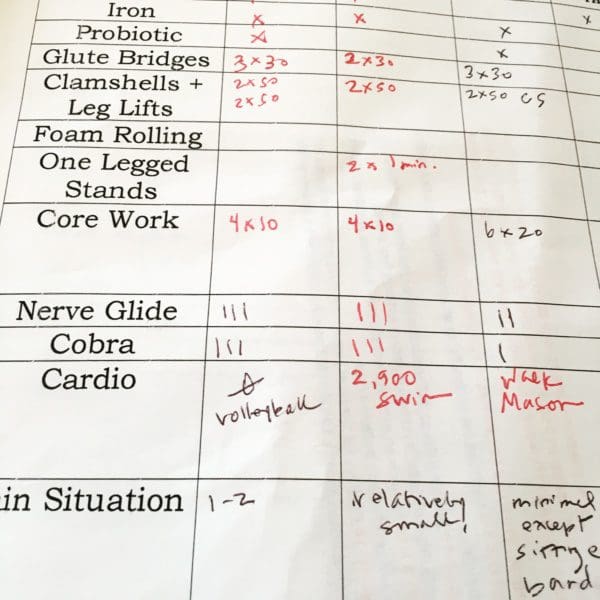
A throw-back moment to one of the times I spent in a boot. (Can’t say I miss those days!)
As I mentioned in my previous rules post—10 Rules for Workouts—I’m on the edge of glory. Oh wait: that’s Lady Gaga.
I’m on the edge of 50, and I’m looking to share a little of my hard-won advice through nearly 30 years of being an endurance athlete.
If I won anything during my running years, it’s the injury race. I don’t need to do a bullet list of my injuries for you (again), but the reality is this: I was rarely able to string together two back-to-back races. The preparation for one race usually brought me to the brink of injury, and then I either survived the race or didn’t even see the starting line.
Looking back, there are many things I’d change about how I handled various physical situations, but we’ll save the clamshell speech for another time. Today, I want to address all the perspectives of running injuries, especially the mental side.
1. No running-induced injury ever improved with simply more running.
If you’ve got a significant situation—stabbing pain, trouble walking, something that causes you to change your typical gait—that concerns you either when you are running or after a run, my very unscientific advice is this: It will not improve by doing exactly what you have been doing. Trust me: I’ve tried myriad times to wish a running injury away, especially when I was in that endorphin-laced positive mood running always put me in.
If you’ve got an injury, you can hit the couch for a day. Then you’ve got to figure out what is causing it, then proactively work to heal it, support it, or balance things out. Simply resting and/or just running keeps things, in the best case scenario, exactly where you currently are—and in the worst case scenario, makes the injury more intense.
2. Accept that most every other physical activity will not feel like running.
Whether you genuinely love your miles or just love how you feel after your miles, running is the gold standard: super accessible; relatively affordable; a calorie torcher; good catch-up time with friends and/or podcasts/music; fresh air in spades. It’s all there.
You’re going to need to adjust your expectations a bit as you transition to the elliptical, bike, strength training, or whatever movement your injury allows you to do.
I’m not saying other forms of cardio and exercise don’t have inherent natural value—they most definitely do—but they don’t taste like running. You may be next to a guy picking his nose on the elliptical; you may feel out-of-sorts in the weight room; you may realize just how overchlorinated your rec pool is. And it’s easy to get down about it all, but if you can adjust your expectations prior to the workout, I can guarantee you’ll be in a better spot.
Put another way: Say your favorite ice cream flavor is peanut butter chocolate. For years, you eat no other ice cream. Then one day, there’s a worldwide shortage of PBC, and you are forced to find a new favorite. Mocha Java Chip is definitely delish, but if you’re expecting PBC on your first spoonful, the java chip won’t sit right. If you tell yourself, java chip is also really good prior to digging in, you’re not going to be as disappointed.
3. Thinking, “I’m not running,” is not helpful.
For a long time (read: years), I classified my off-the-road exercise as Not Running (NR). I was swimming, cycling, walking, hiking, taking Pilates, etc. Sounds like a lot—and it was, time-wise—but mostly, I put those activities under the NR umbrella.
Any guesses on how effective that NR mindset works? Yep, not great. As Dr. Justin Ross has said, Your mind is like a spotlight: it focuses on whatever you choose to shine it on. When you have the klieg lights on NR, that phrase is going to boil around in your brain like a pot of lobsters. (And you know what lobsters do? They scream. #justsaying)
When the NR mindset comes calling—and it still can for me on bad days—you can acknowledge that you are, in fact, not running. Then I recommend tacking on an affirmation like “I’m healing” or “I’m still moving.” It’s also the truth, and it’s a soothing, positive salve.
4. Acknowledge all the pain.
Running injuries feel minor in the world of pandemics, cancer and other big diseases. It can feel ridiculous to complain about them. “Oh, you were just diagnosed with breast cancer? And your mom has MS? Well, I’ve got this hamstring thing that has been going and I haven’t really run in about six months.”
Yeah, not so much. But there’s no value in comparing crises.
Thing is, running injuries don’t have to be debilitating to be all encompassing. On bad days, they can gnaw at you, wearing away patience and compassion for those you love the most. On good days, you can be totally anxious about hitting a dead end in your healing.
Back in the day, I had an integrated Feldenkrais session, a practice that helps restore your body to its natural movement patterns. About halfway through my first session, the practitioner put her hands on my left shoulder and said, “You are in so much pain.” Her statement felt oddly validating.
A running injury may not be life-threatening, but diminishing the effect it has on all aspects of your life is not helpful. You are in pain, and that is significant, no matter what the source.
5. Then manage the physical pain.
When my orthopedic doctor gave me a prescription for what, I later learned via google, is advanced ibuprofen with arthritis relief, I was not thrilled. Arthritis? My grandmother had that in her knuckles. My ego didn’t like that. But my back did.
Same story when I had nervy neck problems from swimming while training for the Aquabike. “We’ve got to get things calmed down so you can heal,” my PT said as he advocated for 800 mg of ibuprofen a couple times a day. “It’s so jacked up right now, we can’t even work on it.”
Whether it’s a heating pad or a prescription or essential oils or turmeric or energy work, do what you need to do to get the pain to a manageable point. There will always be people who are anti-NSAIDS or anti-cortisone shots and preach, quite vocally, about why you should avoid them. Weigh all your choices and listen to different opinions, then do what feels right for you.
Because you need to find some physical relief to let the healing begin.
6. Tune in.
So much of healing comes in shades of gray. I feel better in this position but not in this one; my back was a 4 on a scale of 1-10 yesterday, but now it’s a 6. Why?
I know you don’t need another task, but tuning in to what is working and what isn’t is key. Dry needling might not feel awesome right after your appointment, but do you feel less tension one or two days later?
I’ve become better at looking at the layers underneath how I am feeling. That’s not to say I still don’t crave instant gratification from a therapist—why can’t you just make it all better right now? waaaah—but I do also pause to notice how I’m feeling before a workout. Usually, paying attention at a deeper level reminds me of how much is actually going well in my body and gives me better sense of healing.
7. Be patient.
Your shin splints didn’t happen overnight. Neither did that sore hip or your Achilles issue. You (unknowingly) dug a hole through running miles on some body part that wasn’t functioning correctly; in order to climb out of that sucker and fill it back up properly, you’re going to need time. Probably more time than you want it to take.
If you’re trying to cram PT before a race, slow down and ask yourself, is this race worth potentially heading into a hole deeper than the one I’m in? I know races fill our community, validation, and competition cups, but is one race in a few weeks worth missing six months of running afterward? #justasking
8. Be kind to runners.
This doesn’t mean I advocate standing at the starting line of the half-marathon you can’t run, but jealousy and envy aren’t exactly healing emotions.
When I was first side-lined, it was hard not to virtually, visually spit venom at runners I saw as I drove carpool or to the grocery store. They had no idea how good they had it!
As I calmed down over time, I mentally started sending them good wishes. The wording over the past few years changed regularly, but this one has stuck: May you run well and be well. Every time I see a runner at the gym, on the road, while I’m riding my bike, I almost automatically say this now. Every time, it brings a sense of peace and presence.

A DIY progress tracker. Filling it out is surprisingly fulfilling. (Except I clearly don’t like foam rolling.)
9. Chronicle your progress.
It’s super easy (and emotionally, very fulfilling) to throw up a run on Strava or in Training Peaks, but how satisfying is it to document a 15 minute session on the elliptical? Not very. Still, I’d argue that documenting your situation, both in terms of exercise and pain, is super important for two reasons:
—First, you have a record of what you did. That nebulous am-I-progressing mentality becomes a little easier to clear up when you notice that you did 30 second side planks last week, and now you’re up to 45 seconds.
—Second, you’re keeping yourself accountable. It can be crazy hard to keep up the momentum when you’re improving by centimeters, not meters, and filling in a chart is (and putting your workouts on social media, if you’re so inclined) gives you a gentle push.
10. When the golden moment arrives to run again, have one goal.
That goal? To finish your runs feeling good and wanting more. While you may be ready to bust out the hilly five-mile route you’ve been visualizing for months, now is not that time.
Depending on the length of your off-the-road the first few weeks could likely be a run/walk pattern for 20 minutes. (FWIW, the Return to Running program is a great way to get you to increase your running time safely.) Don’t skimp on the walking, take the running portions at an easy pace, and, most importantly, end every session knowing you could’ve gone longer.
Because, at the end of the day, that’s what we all want: to be able to extend our running days for as long as possible.






Happy pre-birthday Dimity, and thank you for that gold-nugget filled advice. So many wise words! Your transition from running to cycling and swimming accomplishments is truly an inspiration.
Such a good read. It is what I need as a heal from eye surgery. I am sad I can run, walk or do yoga but I know I will be back if I am patient.
Thanks. This is very helpful even though I am not injured. #3 and #7 would have been key to recovery in past injuries. I will definitely save this, just in case.
Well said. Thanks so much for your insight, Dimity. Many happy (and healthy) miles to you!
Well said. Thanks so much for your insight, Dimity. Many happy (and healthy) miles to you!
Well timed post. Thank you.
Another great read! ❤️
This couldn’t have come at a better time! I am sidelined with a work injury and told I cannot run for awhile :( sooo needed to hear this! Thank you🥰
All of this! I am definitely a “I’m not running so I’m not doing anything and I should just run through it” 50 year old. I loved this story. Thank you. Now to get myself one of those progress trackers and fall in love with my spin bike. Happy Birthday, Dimity!
Thank you Dimity! I needed this today. I have a fibula stress fracture (about 2 weeks now), am in PT, and missing the half marathon this upcoming weekend that I was training for. I’m trying to be content with swimming & biking, but…. Anyway, thanks for the safe advice !
So much truth – I needed to read this while I’m sidelined temporarily. It’s hard to get out of the mindset that the elliptical miles “don’t count” because they aren’t “real” running miles. I’m trying to be patient with myself and grateful for what I can still do. Thanks!
Thank you Dimity! Great article! I am just finishing recovery on a rotator cuff tear and some brutal high hamstring tendinosis. After carb loading with chocolate therapy since the end of September, I am desperately trying to hold back and not do too much too soon. It was nice to know that I am not the only one to get injured and that things just take time to heal.
Perfect timing as I contemplated whether to take a running break today because of what feels like hip bursitis. After reading, I decided to do the elliptical, lift and stretch—all pain free. Will re-assess tomorrow.
This is so timely as I’m dealing with Achilles Tendonitis and I’m five weeks away from a 10k and a half marathon two weeks after that’.I’m taking the week off from running and I am feeling better but I still have two more days to nurse this thing before I try out running again.
Love this, Dimity! Returning to running this week after injury and these are all things I need to hear and remember!